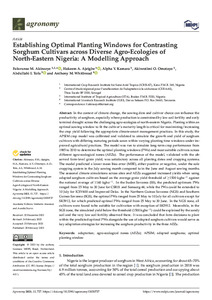| dc.contributor.author | Akinseye, F.M. |
| dc.contributor.author | Ajeigbe, H.A. |
| dc.contributor.author | Kamara, A. |
| dc.contributor.author | Omotayo, A.O. |
| dc.contributor.author | Tofa, A. |
| dc.contributor.author | Whitbread, A.M. |
| dc.date.accessioned | 2023-03-24T08:12:34Z |
| dc.date.available | 2023-03-24T08:12:34Z |
| dc.date.issued | 2023-02-28 |
| dc.identifier.citation | Akinseye, F.M., Ajeigbe, H.A., Kamara, A., Omotayo, A.O., Tofa, A. & Whitbread, A.M. (2023). Establishing optimal planting windows for contrasting sorghum cultivars across diverse agro-ecologies of north-eastern Nigeria: a modelling approach. Agronomy, 13(3): 727, 1-24. |
| dc.identifier.issn | 2073-4395 |
| dc.identifier.uri | https://hdl.handle.net/20.500.12478/8106 |
| dc.description.abstract | In the context of climate change, the sowing date and cultivar choice can influence the productivity of sorghum, especially where production is constrained by low soil fertility and early terminal drought across the challenging agro-ecologies of north-eastern Nigeria. Planting within an optimal sowing window to fit the cultivar’s maturity length is critical for maximizing/increasing the crop yield following the appropriate climate-smart management practices. In this study, the APSIM crop model was calibrated and validated to simulate the growth and yield of sorghum cultivars with differing maturing periods sown within varying planting time windows under improved agricultural practices. The model was run to simulate long-term crop performance from 1985 to 2010 to determine the optimal planting windows (PWs) and most suitable cultivars across different agro-ecological zones (AEZs). The performance of the model, validated with the observed farm-level grain yield, was satisfactory across all planting dates and cropping systems. The model predicted a lower mean bias error (MBE), either positive or negative, under the sole cropping system in the July sowing month compared to in the June and August sowing months. The seasonal climate simulations across sites and AEZs suggested increased yields when using adapted sorghum cultivars based on the average grain yield threshold of ≥1500 kgha−1 against the national average of 1160 kgha−1. In the Sudan Savanna (SS), the predicted optimum PWs ranged from 25 May to 30 June for CSR01 and Samsorg-44, while the PWs could be extended to 10 July for ICSV400 and Improved Deko. In the Northern Guinea Savanna (NGS) and Southern Guinea Savanna (SGS), the optimal PWs ranged from 25 May to 10 July for all cultivars except for SK5912, for which predicted optimal PWs ranged from 25 May to 30 June. In the NGS zone, all cultivars were found to be suitable for cultivation with exception of SK5912. Meanwhile, in the SGS zone, the simulated yield below the threshold (1500 kgha−1) could be explained by the sandy soil and the very low soil fertility observed there. It was concluded that farm decisions to plant within the predicted optimal PWs alongside the use of adapted sorghum cultivars would serve as key adaptation strategies for increasing the sorghum productivity in the three AEZs. |
| dc.description.sponsorship | CGIAR Research Programs Grain Legumes and Dryland Cereals |
| dc.description.sponsorship | Climate Change Agriculture and Food Security |
| dc.description.sponsorship | CGIAR Trust Fund |
| dc.description.sponsorship | World Bank |
| dc.description.sponsorship | United States Agency for International Development |
| dc.format.extent | 1-24 |
| dc.language.iso | en |
| dc.subject | Adaptation |
| dc.subject | Agroecology |
| dc.subject | Sorghum |
| dc.subject | Varieties |
| dc.subject | Planting |
| dc.subject | Nigeria |
| dc.title | Establishing optimal planting windows for contrasting sorghum cultivars across diverse agro-ecologies of north-eastern Nigeria: a modelling approach |
| dc.type | Journal Article |
| cg.contributor.crp | Grain Legumes |
| cg.contributor.crp | Maize |
| cg.contributor.affiliation | International Crops Research Institute for the Semi-Arid Tropics |
| cg.contributor.affiliation | International Institute of Tropical Agriculture |
| cg.contributor.affiliation | International Livestock Research Institute |
| cg.coverage.region | Africa |
| cg.coverage.region | West Africa |
| cg.coverage.country | Nigeria |
| cg.coverage.hub | Headquarters and Western Africa Hub |
| cg.researchtheme | Plant Production and Health |
| cg.identifier.bibtexciteid | AKINSEYE:2023 |
| cg.isijournal | ISI Journal |
| cg.authorship.types | CGIAR Multi Centre |
| cg.iitasubject | Agronomy |
| cg.iitasubject | Crop Systems |
| cg.iitasubject | Farming Systems |
| cg.iitasubject | Food Security |
| cg.iitasubject | Grain Legumes |
| cg.iitasubject | Plant Breeding |
| cg.iitasubject | Plant Production |
| cg.journal | Agronomy |
| cg.notes | Open Access Journal; Published online: 28 Feb 2023 |
| cg.accessibilitystatus | Open Access |
| cg.reviewstatus | Peer Review |
| cg.usagerightslicense | Creative Commons Attribution 4.0 (CC BY 0.0) |
| cg.targetaudience | Scientists |
| cg.identifier.doi | https://doi.org/10.3390/agronomy13030727 |
| cg.iitaauthor.identifier | Alpha Kamara: 0000-0002-1844-2574 |
| cg.futureupdate.required | No |
| cg.identifier.issue | 3: 727 |
| cg.identifier.volume | 13 |

